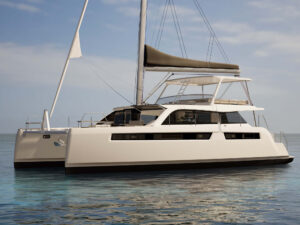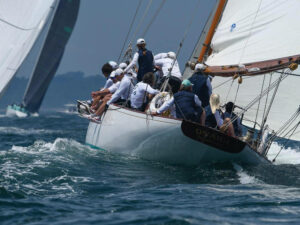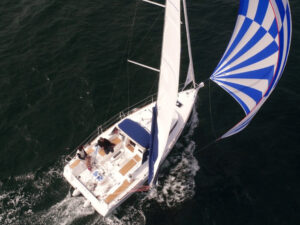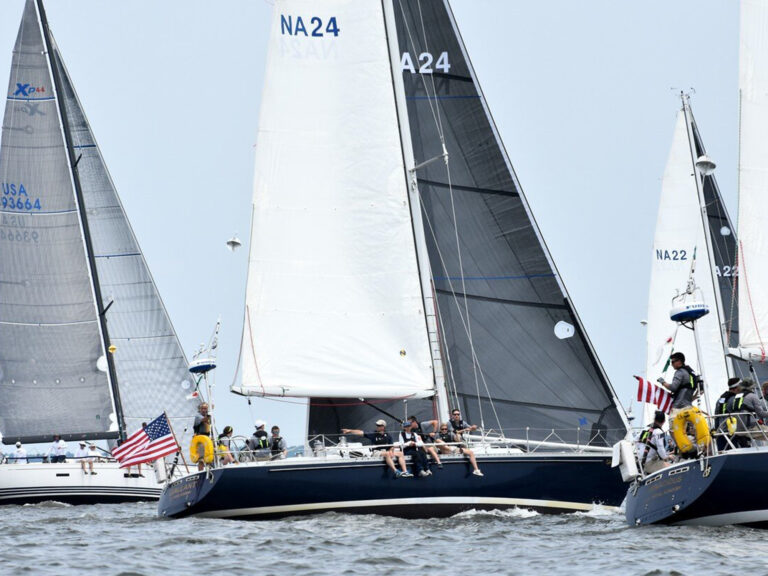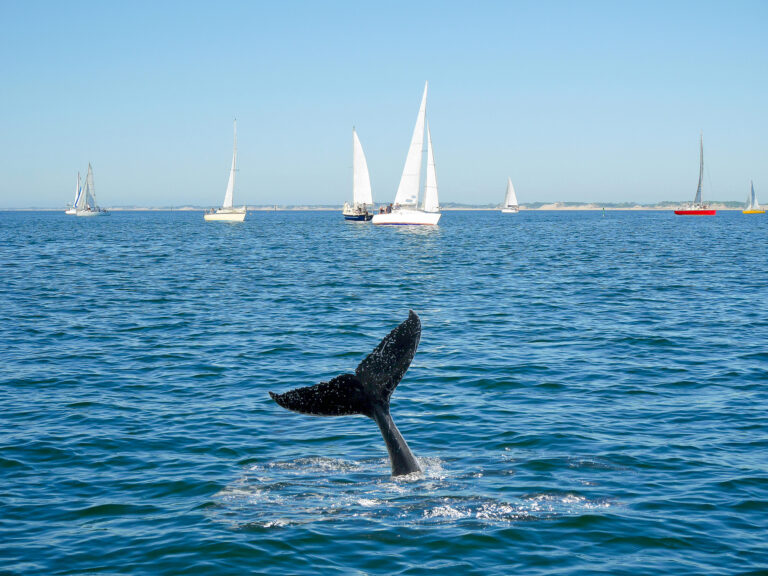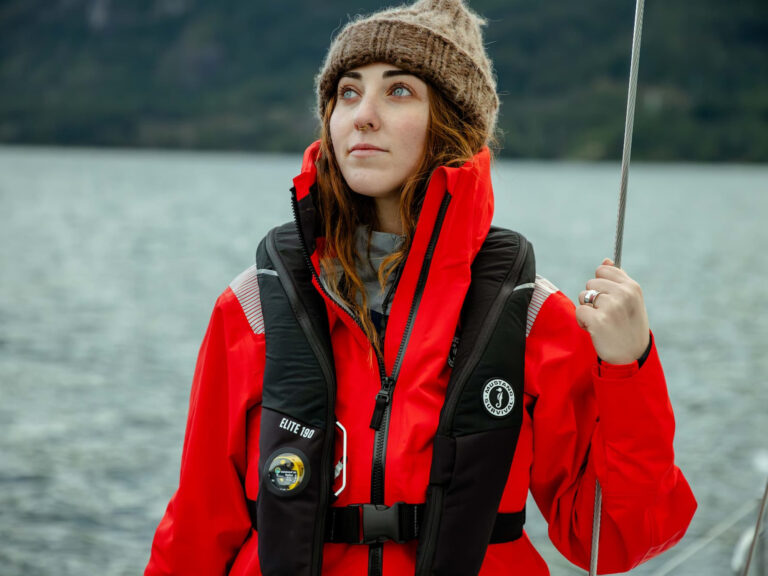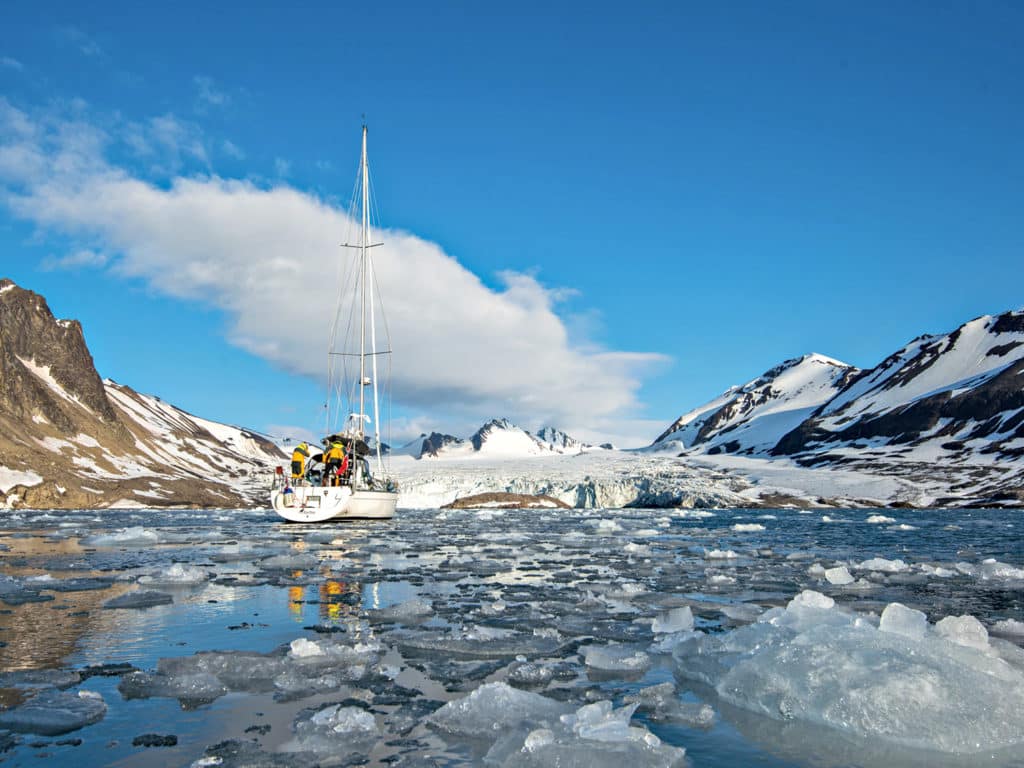
A day to remember: August 16, 2015. The crew of Barba had been sailing north from Stavanger, Norway, for a full seven weeks, making our way along nearly the country’s entire coastline before heading offshore to Svalbard, and then beyond.
The cloud cover was low and as heavy as a duvet, and off in the distance, a polar bear stalked the sea ice before disappearing from view. As far as the eye could see, we were surrounded by ice. And Barba‘s fiberglass hull let us know it too by its creaking and groaning as we maneuvered slowly through the floes, using every skill we’d trained for, on this day.
We had reached the journey’s ultimate goal: to sail as far north as the ocean allowed us in the best boat we had. And our next goal was just as important: to get ourselves and Barba safely back home.
Barba is a 37-foot Jeanneau, intended for sailing in warmer climes. Perhaps it’s not one’s first choice for journeying in polar regions. But the best boat, as the saying goes, is the one you have. That said, gear, crew, preparation and the implementation of all those moving parts are as important as the boat itself. And we had prepared as best we could for the adventure.
Prior to our trip, a number of upgrades were made to Barba to give us the best odds possible in the north. Radar, AIS and forward-looking sonar were among the upgrades to the old navigation equipment. The mast was reinforced with a cutter stay and running back stays. A new engine was installed to replace the faithful one that had served us well for 10 years. And then, of course, there were all of the other upgrades that might escape the naked eye, including a tailored tarpaulin that we could deploy in case of hull leaks, flexible metal plates for more-permanent repairs, meters of Dyneema anchor rodes, and all manner of first-aid materials meant for patching up both the boat and crew while at sea.

As important as the boat, as any sailor knows, is the crew. Two months earlier, following hectic weeks of preparation, the five of us stood ready at the pier in the south of Norway.
Fresh from the German Alps, Daniel Hug is a mountain climber, outdoorsman, photographer and paraglider pilot with almost every skill in the book except notable sailing experience. Terry Ward, from the United States, is a travel journalist, scuba diver and general adventurer with limited sailing experience from previous (and easier) North Sea cruises with Barba. Ivan Kutasov from Russia had been recruited a couple of weeks earlier when we came across an image on Instagram of him sailing in the remote Russian Arctic archipelago of Novaya Zemlya. We got in touch by email and learned that while he worked as a computer programmer, in his heart he was an outdoorsman who had hiked solo for weeks in Siberia, sailed aboard unknown but spectacular Russian sailboats and, most likely, accumulated a few world records for outrunning polar bears and hopping onto rooftops for protection.

To ensure Norwegian sovereignty on board and to maintain the required level of sailing skills too, an old and faithful crewmate from Barba’s Jan Mayen expedition (“Norwegians Would,” April 2016) was enlisted as well. He is Chief Commander Jon Grantangen, a weapons-savvy open airman of the highest class, and now an experienced expedition sailor. And then there was me, the skipper, a Norwegian with trips to Iceland and Greenland under my belt, as well as Jan Mayen, the farthest destination north, until now.
As is always the case when Barba sails off on a high-latitude expedition, a common question arises: Why not sail to warmer areas? For us, it’s not about getting a suntan and sipping rum drinks in a pretty anchorage. Rather, it’s about reaching spectacular destinations that are not practically achievable without a sailboat and an adventurous crew.
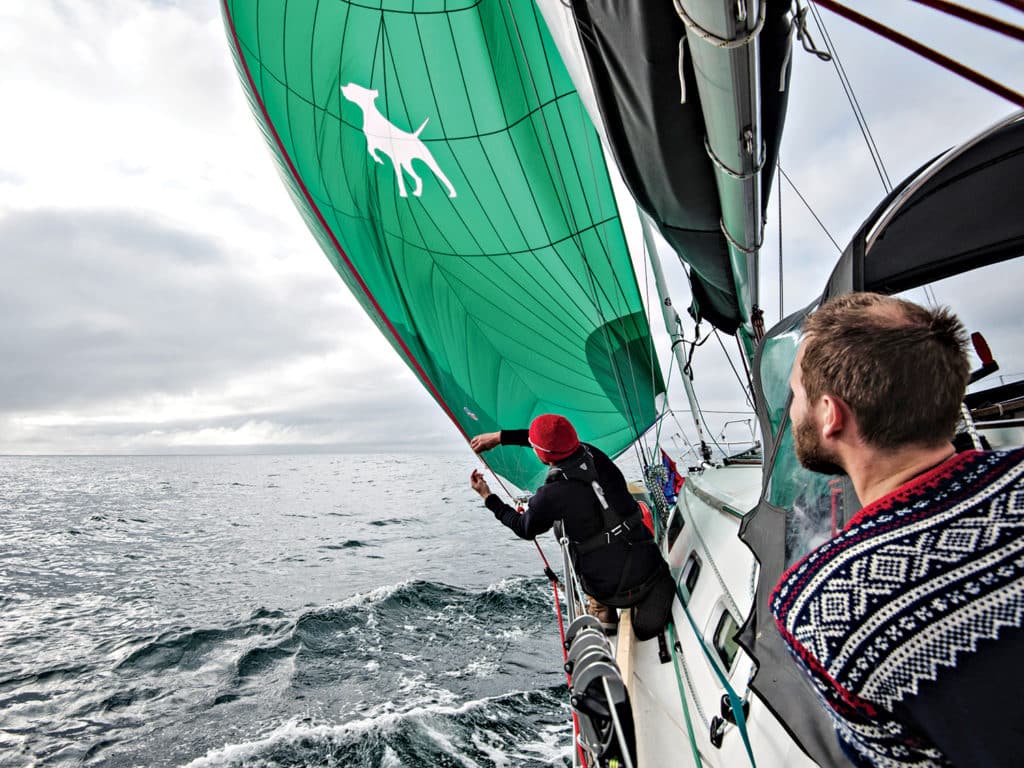
Svalbard had long been a dream of mine. The archipelago off the northern coast of Norway, high above the Arctic Circle, is known for its unspoiled nature, glaciers and epic wildlife such as polar bears, reindeer, walruses and beluga whales. The distance from mainland Norway is surprisingly doable, with a three-day transit. But despite that fact, an extended sailing trip to reach a place like this comes with many challenges for both boat and crew. And it was precisely this combination of adventure, amazing scenery and all-out challenge that became our common inspiration to sail as far north as we possibly could. And what better platform for discovery and adventure is there, after all, than a sailboat?

After a rather pleasant leg up the Norwegian coast, the five of us arrived in Tromsø, as had many a polar adventurer before: giddy to sail away from civilization. On July 15, we saw the mainland disappearing in the proverbial rearview mirror.
With a half-ton of diesel, 40 days’ worth of supplies, paragliders, all manner of scuba diving gear, and weapons for protection from polar bears on board, Barba was riding heavy in the water—but full of hope for distant horizons.
We were still wearing T-shirts when we passed Bjørnøya, or Bear Island, the southernmost island in the Svalbard archipelago. But a day later, the rain came at us sideways. Then, out of nowhere, we saw a bergy bit in the water, a lone piece of ice that was far from titanic but nonetheless felt like a harbinger of what was to come.

The wind was strong and the sea frothing as we approached Sørkapp on the southern tip of the island of Svalbard. After our crossing from Tromsø, we finally spotted the snowy mountains on the horizon on day three. And a fresh breeze carried us to Bellsund, the first natural stopover on the archipelago’s northwest coast.
There had been some sacrifices to the sea along the way, but spirits were high as we dropped anchor at a spot specified in the guidebook. We immediately searched the terrain for polar bears but saw little more than bare mountains, snow and herds of reindeer.
A half-hour later, we decided to move on. After studying the map further, we found a new and better anchorage where we spent the night peacefully. Lesson learned. Guidebooks can be useful and have well-meaning recommendations, but sometimes it’s best to go with your instincts and what you find on your own.

Hornsund, where we ended up by using our own intuition, was one of the highlights of the trip, partly because of the good weather we enjoyed there that allowed everything from mountain hikes to paragliding to maneuvering around ice from calving glaciers. The polar bear tracks we saw on the dark sand beach made for plenty of excitement too, as we scanned the terrain with binoculars, sure we’d spotted the animals. But a closer look proved the shapes were just polar-bear-shaped boulders.
Soon enough, it was on to Longyearbyen, Svalbard’s population center and a most necessary stop on the journey for both provisioning and obtaining information from local acquaintances. Barba was moored modestly next to a number of steel and aluminum expedition boats. We were not to see any of them again as we pushed north.
Our first port of call out of Longyearbyen was Barentsburg, a small and cozy town inhabited nearly entirely by Russians and Ukrainians, which in many ways was more interesting than Longyearbyen because the contrast in living conditions was so different. The pier wasn’t the best here, but the reception was welcoming, and the local food and home-brewed beer ample. A modern sauna and the chance to walk around a city from a bygone era made it an absolute worthwhile stopover before heading into the truly wild areas of Svalbard.

Our route continued from there, north along the west coast of Spitsbergen, where we fed ourselves on fresh-caught deepwater cod, met our first walrus, and stopped for a few days in the international research settlement at Ny-Ålesund to refill the diesel and party into the midnight sun with scientists stationed there for the summer.
For cultural interest, Virgohamna Nordvest in Svalbard was an interesting stopover. A former Dutch whaling station, it’s the place to see the remnants of the equipment used to send off Salomon August Andrée and Walter Wellmans in their attempt to reach the North Pole by hot air balloon (a mission that turned out to be one with a one-way ticket).
The biggest highlight came when several of the crew decided to try spending the night on land in a tiny hunting cabin that was open for overnight stays. Daniel and I were charged with keeping watch on the boat, and when we went to shut the hatches for the night, we saw a polar bear stalking on land. The initial high of our first sighting was quickly replaced by nervousness, as the bear was slowly picking its way toward where the rest of the crew were sheltering for the night. But the majestic King of the Arctic soon headed off on an alternate route around the bay. Daniel and I marveled at the sight of him from the dinghy—I had sprung into action, shotgun in hand, in case of a potential encounter—while our mates were similarly impressed from their quarters ashore.

Svalbard accounts for 19 percent of Norway’s total landmass. The main island of Spitsbergen in the west is flanked by Nordaustlandet in the east and Barentsøya and Edgeøya islands in the south. Even though we had five weeks at our disposal to explore the archipelago, we were limited in what we could discover—there is just so much to see in this part of the world.
One of the many high points while sailing around Spitsbergen was finding a harbor where we could spend happy days as true adventurers under the never-ending midnight sun. Volumes of driftwood made building a fire a natural activity, and we even found waterways to fish that were positively teeming with Arctic char.
The landscapes here have the look of an Arctic desert, yet the contrast underwater is incredible—once you put on a mask, snorkel and drysuit to brave the freezing ocean temperatures. Colorful anemones decorate the sea bottom, along with all kinds of mollusks.
One morning in the northeastern reaches of Spitsbergen, I looked over my shoulder while pulling up anchor on an early watch. A couple of yards behind the boat, something giant was swimming in the flat water. The polar bear alarm was sounded, and it was suddenly all hands on deck.

A young male bear was approaching the boat, with breakfast in mind. We managed to keep him at bay with a large wooden pole intended to move ice away from the boat, slapping the water at times to startle the bear into keeping its distance, and yelling at the animal in Norwegian, English, German and Russian. The bear retreated in the end to a perch on a rock over the water, and seemed to watch us with both dismay and curiosity until we sailed out, bound for farther north still.
After studying ice and weather maps downloaded over satellite phone, we sailed past Sjuøyane, the last piece of land before the North Pole. And at 81 degrees north, Barba was finally halted by pack ice. Surrounded by frozen brine in every direction, we had finally met our limit—and realized our ultimate goal.
We piled out of the boat onto an ice floe the size of a basketball court, and broke out some schnapps from South Tyrol to celebrate. Two members of the crew suited up in their drysuits to go for a scuba dive—one of those things you most likely do just to say you’ve done it. The view below was endless blue, and small jellyfishlike creatures in the freezing cold water was all there was to see.
Later, as we retreated into the open water, we remembered the wise words of our Russian crewmember: It’s hard to sail to the Arctic, but even harder to sail back home again. An uptick in wind had made the ice shut in around us, and the radar showed that we were surrounded. The next couple of hours were spent slowly navigating our way out, pushing with those polar-bear-repelling wooden poles as Barba‘s fiberglass exterior groaned in trepidation.
After 56 days cruising, it was with a great sense of relief that we finally headed back south toward the green-clad mountains and warmer waters of mainland Norway.
But there were other highlights before we left Svalbard, including beluga whale sightings and the chance to sail past the Blåsvell Glacier that covers large parts of Nordustlandet. It is a continuous ice cap of some 8,500 square kilometers; Barba was dwarfed in front of its vertical ice wall looming some 30 meters high.
Moments like those, and many more, go down in the memory books for life. And when we finally made it back to the quay, which we’d last seen some four months earlier, the champagne awaiting us felt well-earned indeed.
The Barba expedition to Svalbard was intended to be an adventure, using the boat as a platform for close interaction with nature. It will never go into any history books of explorations. But in terms of boat and crew, we were pleased to cover some 4,040 nautical miles without damage to either. We had done it. We’d fended off polar bears, flew paragliders from mountain peaks where it had never before been done, and raised our glasses in a toast to adventure on an remote ice floe as far north as we could sail.
And then we’d made it back safely to where it all began.
Andreas Heide is a conservationist and marine biologist from Norway, and is currently preparing his sailboat Barba for an expedition to document whales in the North Atlantic.
Looking for Adventure?
Andreas Heide and Team Barba are planning a return voyage to Svalbard in 2020. They are currently looking for crewmembers, onshore support and partners for the project. If interested, contact Heide at barba.no.
Tips for Sailing to Svalbard
A good anchor and windlass are high on the priority list. There’s good information online for what type of anchor is recommended in Svalbard. Aboard Barba, I use 100 feet of 8-millimeter chain (I limit it to this length because of weight) and an additional 300 feet of 18-millimeter line. Since that trip to Svalbard, I have upgraded to a Lofrans windlass and a 20-kilogram Spade anchor. I also carry a 3.2-kilogram Fortress anchor that I can attach in series with the spade anchor. And I have acquired an anchor sail to keep the bow to the wind.
Undoubtedly the best guidebook for the area is The Norwegian Los, which is available for free online.
The best ports of call not mentioned in the guidebook were found by studying charts and paying close attention to the weather forecast for upcoming days.
To sail to Svalbard, you must apply for a permit with the governor, which is an affordable and straightforward process.
A satellite phone is an absolute necessity for downloading weather files and ice maps.
Condensation is a classic problem in the high latitudes. Insulate the mast with self-adhesive mats, use insulation under mattresses and along the hull, and be sure to have sufficient diesel on board to keep the boat heated.
Polar bears inhabit the entire archipelago and are often hungriest during summer. Follow the instructions from the Norwegian Polar Institute on this matter, and there will likely never be a tragic outcome for bear or human should an encounter occur. When traveling outside Longyearbyen limits, it’s imperative to be armed with a powerful rifle in case of an encounter.
It is recommended that cruisers have experience sailing in polar areas before passing the northernmost point of Spitsbergen. First-time adventurers in these environs should consider sticking to the west coast.


